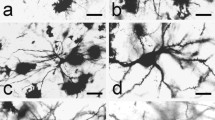Summary
In chicks, monaurally deafened at 3 weeks of age, 2-deoxyglucose labeling of the input layer L2 in the auditory neostriatum (field L) was analyzed after acoustic stimulation. Two types of stimuli were used: narrow band frequency modulations and white noise. Both stimuli provide evidence that there are bands or columns with different inputs from the contra- and ipsilateral ear, a rostral, intermediate, and caudal band, all oriented orthogonal to the isofrequency contours. The intermediate band, in addition, shows multiple alternating columns of ipsivs. contralateral dominant input, parallel to the isofrequency contours. Consequently, the tonotopic gradient is interrupted several times by these columns. The organization of field L bears interesting parallels to the mammalian auditory cortex and is the first evidence of columnar organization in a submammalian forebrain. The multiple interruptions of the tonotopic gradient between low and high frequencies in the intermediate band by alternating aural dominance has possible implications for understanding directional hearing, as well as for understanding formant analysis of species-specific sounds.
Similar content being viewed by others
References
Abeles M, Goldstein MH, Jr (1970) Functional architecture in cat primary auditory cortex. J Neurophysiol 33: 172–187
Bonke D, Scheich H, Langner G (1979a) Responsiveness of units in the auditory neostriatum of the Guinea fowl (Numida meleagris) to species-specific calls and synthetic stimuli. I. Tonotopy and functional zones of field L. J Comp Physiol 132: 243–255
Bonke BA, Bonke D, Scheich H (1979b) Connectivity of the auditory forebrain nuclei in the Guinea fowl (Numida meleagris). Cell Tissue Res 200: 101–121
Coles RB, Aitkin LM (1979) The response properties of auditory neurones in the midbrain of the domestic fowl (Gallus gallus) to monaural and binaural stimuli. J Comp Physiol 134: 241–251
Coles RB, Lewis DB, Hill KG, Hutchings ME, Gower DM (1980) Directional hearing in the Japanese quail (Coturnix coturnix japonica). II. Cochlear physiolog. J Exp Biol 86: 153–170
Hubel DH, Wiesel TN (1962) Receptive fields, binocular interaction and functional architecture in the cat's visual cortex. J Physiol 160: 106–154
Hungerbühler JP, Sanders JC, Greenberg J, Reivich M (1981) Functional neuroanatomy of the auditory cortex studied with [2–14 C] deoxyglucose. Exp Neurol 71: 104–121
Imig TJ, Adrian HO (1977) Binaural columns in the primary field (AI) of cat auditory cortex. Brain Res 138: 241–257
Knudsen EI, Konishi M (1978a) A neural map of auditory space in the owl. Science 200: 795–797
Knudsen EI, Konishi M (1978b) Center-surround organization of auditory receptive fields in the owl. Science 202: 778–780
Langner G, Bonke D, Scheich H (1981) Neuronal discrimination of natural and synthetic vowels in field L of trained mynah birds. Exp Brain Res 43: 11–24
Leppelsack H-J (1974) Funktionelle Eigenschaften der Hörbahn im Feld L des Neostriatum caudale des Staren (Sturnus vulgaris L., Aves). J Comp Physiol 88: 778–781
Lewis DB, Coles RB (1980) Sound localization in birds. TINS 23: 102–105
Lippe WR, Steward O, Rubel EW (1980) The effect of unilateral basilar papilla removal upon nuclei laminaris and magnocellularis of the chick examined with [3H] 2-deoxy-D-glucose autoradiography. Brain Res 196: 43–58
Middlebrooks JC, Dykes RW, Merzenich MM (1980) Binaural response-specific bands in primary auditory cortex (AI) of the cat: Topographical organization orthogonal to isofrequency contours. Brain Res 181: 31–48
Mountcastle VB (1957) Modality and topographic properties of single neurons of cat's somatic sensory cortex. J Neurophysiol 20: 408–434
Rubel EW, Smith D, Miller LC (1976) Organization and development of brain stem auditory nuclei of the chicken: Ontogeny of n. magnocellularis and n. laminaris. J Comp Neurol 166: 469–489
Scheich H, Langner G, Bonke D (1979a) Responsiveness of units in the auditory neostriatum of the Guinea fowl (Numida meleagris) to species-specific calls and synthetic stimuli. II. Discrimination of iambus-like calls. J Comp Physiol 132: 257–276
Scheich H, Bonke BA, Bonke D, Langner G (1979b) Functional organization of some auditory nuclei in the Guinea fowl demonstrated by the 2-deoxyglucose technique. Cell Tissue Res 204: 17–27
Scheich H, Bonke BA (1981) Tone-versus FM-induced patterns of excitation and suppression in the 14-C-2-deoxyglucose labeled auditory “cortex” of the Guinea fowl. Exp Brain Res 44: 445–449
Scheich H, Bock W, Bonke D, Langner G, Maier V (1983) Acoustic communication in the Guinea fowl (Numida meleagris). In: Ewert P (ed) Advances in vertebrate neuroethology. Plenum Press, New York, pp 731–782
Sokoloff L (1975) The coupling of function, metabolism and blood flow in the brain. In: Ingvar HD, Lassen NA (eds) Brain work. Copenhagen Munksgaard, pp 385–388
Author information
Authors and Affiliations
Additional information
Supported by the Deutsche Forschungsgemeinschaft, SFB 45
Rights and permissions
About this article
Cite this article
Scheich, H. Two columnar systems in the auditory neostriatum of the chick: Evidence from 2-deoxyglucose. Exp Brain Res 51, 199–205 (1983). https://doi.org/10.1007/BF00237195
Received:
Issue Date:
DOI: https://doi.org/10.1007/BF00237195




